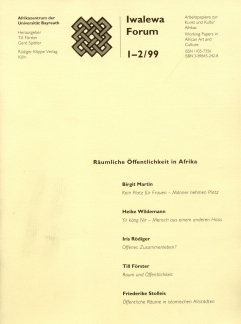
Räumliche Öffentlichkeit in Afrika
With contributions by: Till Förster, Birgit Martin, Iris Rödiger, Friederike Stolleis, Heike Wildemann. Series edited by: Till Förster, Gerd Spittler. Series edited in collaboration with: Barbara Mayer.
Series: Iwalewa Forum Working Papers in African Art and Culture Year 1999, Issue 1-2
199992 pp.
9 b/w photos, 5 graphs
Text language(s): German
Format: 210 x 275 mm
340 g
Paperback
€ 49.80
Order 'Räumliche Öffentlichkeit in Afrika' as print edition »
CONTENTS
Birgit Martin:
Kein Platz für Frauen – Männer nehmen Platz
In the present article the author describes gender-specific space in the village el-Korey in northern Sudan along the river Nile. El-Korey is inhabited by four endogamous ethnic groups, the Shaigîya, Sûdânîya, Hawâwîr und Hassanîya, who still live in separate quarters of the village. The author focuses on the private and public spaces of men and women, and especially on the delimitation of female scope by her male relatives. However, the author shows that the equation of men with the public sphere and women with the private sphere is only of limited validity but that both spheres increasingly converge. Today, the separation of the sexes is gained more by dividing the living quarters rather than by the internalization of values as it was achieved in former times.
Heike Wildemann:
Yir kang Nir – Mensch aus einem anderen Haus
This article shows how Dàgàrà women view the concepts of ‘place’ and ‘space’. The social situation of the women in northern Ghana and southern Burkina Faso is characterized by their change of affiliation to place and clan of their husbands in the case of marriage. The author investigates how these women, to whom only the status of a guest is given even at their husbands’ house, define their affiliation to a certain place, and which spaces of everyday life give them room for identification and the liberty to act. In her investigation the author analyses numerous conversations with women during her period of field study with the Dàgàrà covering several months.
Iris Rödiger:
Offenes Zusammenleben?
The author describes the organisation of space in the society of the Nyarafolo in the north of the Ivory Coast and investigates the consequences of architecture on their social life. Her focus is on the form and function of houses and yards. Within each village the houses of men and women differ both in form and function. For instance, the houses of men are traditionally square, whereas those of the women are round. Following these descriptions, the author deals with the connections between the open architecture of the village and the common social life of the people, proposing that the openness of the houses and yards could be a result of the openness of the society.
Till Förster:
Raum und Öffentlichkeit
The author has the following questions as his starting-point – How do actors articulate themselves in the public of the village, and where do the chances for the individual in influencing and forming this public lie? There are only few spaces which remain unobserved by others in those villages of the West African savanna studied by the author. The author distinguishes between ‘contingent spaces’ (villages, farmsteads, houses, audiovisual spaces) and intentional spaces (confidentiality and intimacy, motions and encounters, meetings) and concludes that in a society where almost everything can be publicly observed by others only the intended purposes behind the acts remain in the sphere of privacy. Purposes and intentions can be made explicit, but what the other one actually sees and experiences can differ.
Friederike Stolleis:
Öffentliche Räume in islamischen Altstädten
Focusing on ethnographic, geographic and orientalist sources the author investigates the structure and nature of traditional Islamic towns in the Middle East and Northern Africa. The urban public presented by her is designed for illuminating the traditional cultural contexts in which the people move and act in public space. The author analyses the public character of several places and institutions central to Islamic old towns - urban markets, mosques, public baths, coffee houses and living quarters. Instead of a public which is open to everybody she finds here a segmentary, local public which is the result of the segregation of the sexes and of various groups of the society, and of the important function of neighbourhoods as social units.
Under these links you will find further studies of the conceptualization of space, distance, privacy and public in various languages and cultures:
Accompanying material:
- Anthropologie des Raumes
(ISBN 978-3-89645-217-7 ) - Fremde Nachbarn
(ISBN 978-3-89645-818-6 ) - Living with the Lake
(ISBN 978-3-89645-216-0 ) - Siedler am Tschadsee
(ISBN 978-3-89645-218-4 ) - To Live with Others
(ISBN 978-3-89645-827-8 )
Cross-reference:
- Comparing African Spaces
(ISBN 978-3-89645-013-5 ) - Freundschaft und Macht
(ISBN 978-3-89645-164-4 ) - Konzeptualisierung von Landschaft
im Mbukushu (K.333/K.43) Bantusprache in Nord-Namibia)
(ISBN 978-3-89645-600-7 ) - Räumliche Orientierung in nilotischen Sprachen
(ISBN 978-3-89645-661-8 ) - Spaces in Movement
(ISBN 978-3-89645-905-3 ) - Verwandtschaft, Geschlecht und Raum
(ISBN 978-3-89645-163-7 )
| « back | Print version | [top] |
 Books
Books Audio
Audio Biographies
Biographies Series
Series Festschrifts
Festschrifts Journals
Journals